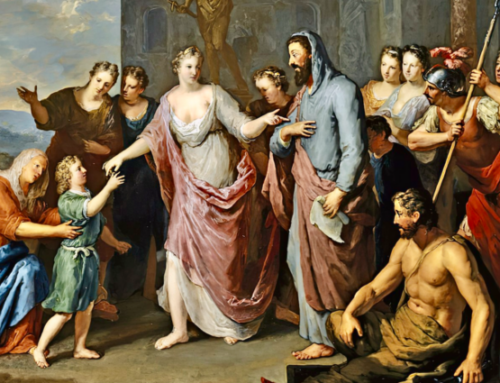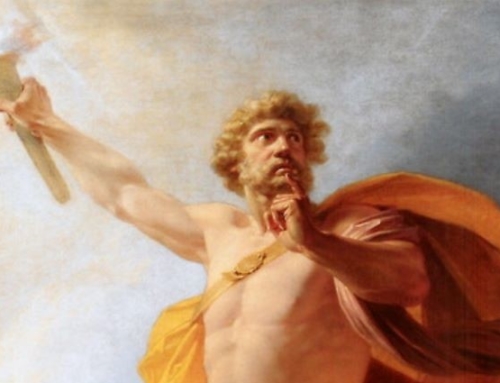 Throughout history, cultures have always developed fantastical tales of heroes and gods and monsters and demons. Whether they are tales of the Greek Pantheon, Norse gods, or modern-day superheroes, these tales grasp the imagination and transport the hearer to a different realm full of possibility. The question then arises in my mind: Are these myths merely fiction or is there meaning behind the veil of words? Why are we as men drawn to these stories and enthralled by them? To answer these questions, one must delve into what it means to be a myth.
Throughout history, cultures have always developed fantastical tales of heroes and gods and monsters and demons. Whether they are tales of the Greek Pantheon, Norse gods, or modern-day superheroes, these tales grasp the imagination and transport the hearer to a different realm full of possibility. The question then arises in my mind: Are these myths merely fiction or is there meaning behind the veil of words? Why are we as men drawn to these stories and enthralled by them? To answer these questions, one must delve into what it means to be a myth.
Myths, nowadays, come under fire for being “false.” They are referred to as mere fantasies to entertain and distract us from real life. These critics of myth give myth no purpose or place in the busy life of modern man with his comings and goings. Such men strip away the facade and trappings of life to expose a bare bones existence that lies beneath. A life we must live devoid of the fantastical, for they have removed all that is unnecessary to improve the efficiency of our everyday interactions and business.
I argue that myths, rather than being false, bring us closer to the truth than other forms of investigation can. There are many forms of truth that we encounter throughout life. There is scientific truth which we know through experimentation and investigation; historical truth which is given to us through witnesses and their accounts; and transcendent truths which are revealed in myths, fables, and art. To see this, I will first describe what a myth is and the purpose it serves in our lives.
To understand what a myth is, I must first present an explanation of what I mean by “transcendent truths.” These are truths that are not verifiable through the scientific method; neither are they observable with our senses. However, they are things that are recognized to exist by all: such phenomena as love, beauty, goodness, or courage. They are transcendent because their existence is above the plain of the physical world. It is such truths as these that myths reveal to us. This is both the purpose and aim of myth.
Myth accomplishes this purpose by creating heroes and villains that are oftentimes wildly exaggerated. We give to them powers and purpose that are far greater than anything a human could possess. This enables their stories to be bigger than life. In doing this, it uncovers the truths hidden beneath, as if a magnifying glass had been held up to them. In the exaggeration, it is easier to find examples of courage or beauty or whichever truth is being portrayed in the myth. It is at this point that the reader can take that revealed truth and examine it for what it is.
In this way, myth, although not factual, is still true. For myth gives to us a glimpse of higher truths that are unreachable using mere words. Not only do they reveal these truths to us, but they inspire our imaginations to attain to these truths. I would back this up with an appeal to the beauty of poetry. In poetry, the poet uses metaphors and similes to express an idea that is above the scope of prose. Once again, the poet, like the author of myth, is trying to reveal to the reader these transcendent truths.
No one would read a poem and complain that he cannot take the words in the poem literally. Doing this would make no sense at all since the words were not written to be literal but transcendental. The words are a prop that appeal to our imaginations to draw our minds to higher and nobler ideas. To inspire us to be better than we could hope to be based in a purely physical world.
A famous example of fables that are used to express transcendent truths are Aesop’s Fables. In these fables, Aesop presents short stories of animals that he has anthropomorphized. In these tales there is an interaction that allows us to see a truth. Of the many examples, the story of the tortoise and the hare is one of the better-known ones. In this fable, the tortoise and the hare race. Whereas everyone expects the hare to win, the tortoise prevails. This happens because the hare was overconfident and took a nap while the tortoise trudged along to the finish line. The moral normally attached to this tale is “slow and steady wins the race.” This points to the transcendent truth of perseverance.
Other such fables and myths can be analyzed, and through them we can receive insight into many truths that were unperceivable before. This is the important place that myths hold in our society and culture. With modernity’s degradation of the myth, we are losing a valuable resource to instruct the youth and general populace in moral and transcendent truths. Related to this, there is art, which serves a similar purpose to the myth.
Myth serves as a guide to truth through the means of words, structuring itself as a metaphor for what is transcendent. Art is myth’s visual counterpart. Both appeal to the imagination to grasp and learn higher realities. In the same way that myth is important, art as well is needed to complement the spectrum of tools we can use to become enlightened.
When the artist paints, his goal is not to capture reality as we see it. For that, we have the camera. The artist’s goal is to capture the essence of the subject’s being and portray the inner truth that binds the subject and makes it what it is. This is done by identifying specific traits in the setting and emphasizing those so they draw the beholder’s eye. This emphasis shows the viewer a glimpse into the inner beauty of the subject.
As in myth, where the hero and villain are larger than life and possess extremes of virtue and power, so too must the artist portray his subject to the extreme. This allows the viewer to understand and be drawn to the truth that the artist is portraying. If the artist wishes to portray something as evil, he emphasizes the faults and failings in the subject; if good, he emphasizes the opposite. In this way, good art draws the viewer to understand truths that are not able to be perceived by merely seeing the subject with his eyes.
If these ideas die, if myth fails, if art is ugly, then our ability to reach beyond the physical is greatly hindered. Our limited reasoning will be hindered in its attempt to reach the transcendent. For these reasons, healthy myths and art are vital for a society and culture to thrive. Without them, we are imprisoned in the cold dreary prison of the purely rational world.
The Imaginative Conservative applies the principle of appreciation to the discussion of culture and politics—we approach dialogue with magnanimity rather than with mere civility. Will you help us remain a refreshing oasis in the increasingly contentious arena of modern discourse? Please consider donating now.
The featured image is “Perseus and Andromeda” (1870) by Gustave Moreau (1826-1898) and is in the public domain, courtesy of Wikimedia Commons.







I liked this article. It succeeded with me in its simplicity of explanation of the subject of the essay, myths. I have a clearer understanding of transcendent.